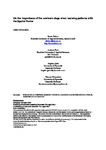On the Importance of the Newborn Stage When Learning Patterns with the Spatial Pooler
| dc.contributor.author | Dobric, D | |
| dc.contributor.author | Pech, A | |
| dc.contributor.author | Ghita, B | |
| dc.contributor.author | Wennekers, Thomas | |
| dc.date.accessioned | 2022-05-03T13:24:54Z | |
| dc.date.available | 2022-05-03T13:24:54Z | |
| dc.date.issued | 2022-03-03 | |
| dc.identifier.issn | 2661-8907 | |
| dc.identifier.issn | 2661-8907 | |
| dc.identifier.other | 179 | |
| dc.identifier.uri | http://hdl.handle.net/10026.1/19150 | |
| dc.description.abstract |
Hierarchical Temporal Memory (HTM-CLA) - Spatial Pooler (SP) is a Cortical Learning Algorithm for learning inspired by the neocortex. It is designed to learn the spatial pattern by generating the Sparse Distributed Representation code (SDR) of the input. It encodes the set of active input neurons as SDR defined by the set of active neurons organized in groups called mini-columns. This paper provides additional findings extending the previous work, that demonstrates how and why the Spatial Pooler forgets learned SDRs in the training progress. The previous work introduced the newborn stage of the algorithm, which takes a control of the boosting of minicolumns by deactivating the Homeostatic Plasticity mechanism inside of the SP in layer 4. The newborn stage was inspired by findings in neurosciences that show that this plasticity mechanism is only active during the development of newborn mammals and later deactivated or shifted from cortical layer L4, where the SP is supposed to be active. The extended SP showed the stable learned state of the model. In this work, the plasticity was deactivated by disabling the homeostatic excitation of synaptic connections between input neurons and slightly inactive mini-columns. The final solution that includes disabling of boosting of inactive mini-columns and disabling excitation of synaptic connections after exiting the introduced newborn stage, shows that learned SDRs remain stable during the lifetime of the Spatial Pooler. | |
| dc.format.extent | 179- | |
| dc.language | en | |
| dc.language.iso | en | |
| dc.publisher | Springer | |
| dc.subject | Brain Disorders | |
| dc.subject | Neurosciences | |
| dc.title | On the Importance of the Newborn Stage When Learning Patterns with the Spatial Pooler | |
| dc.type | journal-article | |
| plymouth.issue | 2 | |
| plymouth.volume | 3 | |
| plymouth.publication-status | Published | |
| plymouth.journal | SN Computer Science | |
| dc.identifier.doi | 10.1007/s42979-022-01066-4 | |
| plymouth.organisational-group | /Plymouth | |
| plymouth.organisational-group | /Plymouth/Admin Group - REF | |
| plymouth.organisational-group | /Plymouth/Admin Group - REF/REF Admin Group - FoSE | |
| plymouth.organisational-group | /Plymouth/Faculty of Science and Engineering | |
| plymouth.organisational-group | /Plymouth/Faculty of Science and Engineering/School of Engineering, Computing and Mathematics | |
| plymouth.organisational-group | /Plymouth/REF 2021 Researchers by UoA | |
| plymouth.organisational-group | /Plymouth/REF 2021 Researchers by UoA/UoA11 Computer Science and Informatics | |
| plymouth.organisational-group | /Plymouth/Users by role | |
| plymouth.organisational-group | /Plymouth/Users by role/Academics | |
| dcterms.dateAccepted | 2022-02-11 | |
| dc.rights.embargodate | 2023-3-3 | |
| dc.identifier.eissn | 2661-8907 | |
| dc.rights.embargoperiod | Not known | |
| rioxxterms.versionofrecord | 10.1007/s42979-022-01066-4 | |
| rioxxterms.licenseref.uri | http://www.rioxx.net/licenses/all-rights-reserved | |
| rioxxterms.type | Journal Article/Review |


